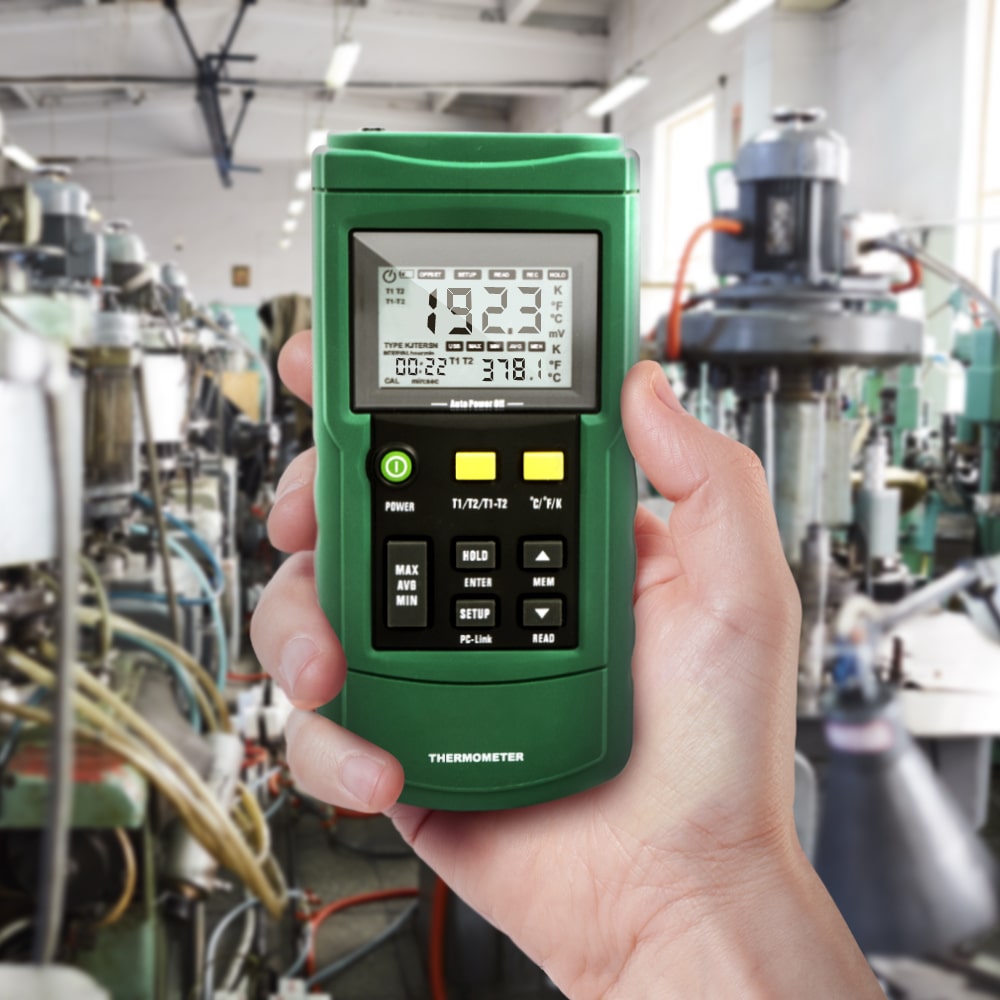The thermocouple thermometer serves an important purpose by accurately measuring sensitive temperatures with great precision so that the user has the best results. Its low price point paired with its design and durability really makes it an important asset especially for those in the furnace or oven industry.
Hearing this, i'm sure there are still lots of unanswered questions regarding this meter and this blog will get to the heart of the questions and serve as a foundation of knowledge regarding the matter.
1. What is the temperature range of a thermocouple thermometer?
Most importantly a large temperature range is the thermocouple thermometer’s greatest asset, they typically have a range from zero to 1800˚C. That’s definitely a wide range considering RTD’s can go from -240˚C to as high as 650˚C only. Thermistors fare even far less, donning an even shorter range of -100 to as high as 325˚C. Or about half the size of RTDs.
In table form:
|
Sensor Type |
Thermocouple |
RTD |
Thermistor |
|
Temperature Range |
0 to 1800˚C |
-240 to 650˚C |
- 100 to 325˚C |
However, know that the exact temperature range of a particular thermocouple you may be interested in will largely depend on the type of thermocouple you are facing. So even when thermocouples shine when it comes to range, you need to do your due diligence to check which particular thermocouple you need as each type (e.g., type B, type E, type J, type K) will have a distinct temperature range.

2. How does a thermocouple thermometer work?
The underlying principles that make a thermocouple thermometer work can be traced back to the Seebeck effect also known as the thermoelectric effect. Named after the German physicist in the 19th Century, Thomas Johann Seebeck, the Seebeck effect manifested itself to the scientist in 1821 when “a junction of dissimilar metals” put a magnetic needle into motion once exposed temperature changes. Initially called the “thermoelectric effect”, the Seebeck phenomenon showed a direct proportionality between the amount of voltage (in millivolts) produced to the temperature difference. Hence a new way to measure temperature.
3. How to calibrate a thermocouple thermometer?
Every now and then a thermocouple will have to be calibrated to continue producing quality numbers. Akin to getting your car timely maintenance finetuning (e.g., change oil).
As technical as a thermocouple is, more often than not, you’ll need an expert hand to do these things for you. To note, here are 3 of more popular ways to calibrate a thermocouple thermometer:
This is the most accurate way of calibrating a thermocouple. However, the process is slow and taxing and is best delegated to an experienced technician working in a lab.
To do this, you need to employ a furnace or a stirred liquid bath accordingly depending on the particular temperature requirement. The process involves the thermocouple unit to be submerged in the furnace or liquid bath together with another pre-calibrated sensor. As it’s meticulous and extensive and is also best done in a lab setting.
This has got to be the most preferred method for most as this can be done right where you are and outside of a lab. In short, just about anywhere.
To do this, the thermocouple goes through a calibrator which comes with a metal block complete with holes fitted with a sensor. After inserting the thermocouple unit, the metal block will have to undergo heating or cooling depending on the temperature adjustments needed based on the differences in the discrepancy of the temperature reading taken from the thermocouple and that of the block. An additional temperature sensor could be used to get the reading of the latter.

4. Where to buy a thermocouple thermometer?
Buying an electronic product is one thing; getting the support you need to get the product to function seamlessly for the longest time is another.
Like most, if not all, products on the market today worth your time and effort, a thermocouple thermometer can be had from popular stores online. However, if you want to get more value for your money, getting a top-quality product from trusted companies that provide ample sales and technical support is best. Not to mention an affordable price tag.
And that’s exactly what PerfectPrime’s and its offering have shone its light for you. More bang for your buck.
5. How to use a thermocouple thermometer?
To understand how to use a thermocouple thermometer you must remember that the electronic contraption is basically the union of two dissimilar metals. As such, there are two key parts of a thermocouple:
- The input end
- The output end
The input end is the point where the two dissimilar metals meet. This is the probe - by which you have the thermocouple come in contact with the element to be measured (e.g., your hand, heated water, PCB, etc.).
Conversely, you have the open end of the thermocouple, the point where the metals are separate. Alternatively, this open end is called the output end as the voltage (emf) produced at this end is directly proportional to the temperature observed at the input end (joint end). Then, the millivolt-output generated can be interpreted, by using a microprocessor, for instance, to display the measured temperature in readable terms.
6. Why use a thermocouple instead of a thermometer?
Technically, a thermocouple is a type of thermometer as it’s a sensor that can also detect temperature changes in the material being examined. However, if by thermometer you mean the traditional mercury-in-glass thermometer, then a thermocouple has distinct advantages.
Firstly, a traditional thermometer won’t be able to handle extremely high temperatures. Chances are a conventional mercury sensor will break before reaching 1000˚C. Mercury changes from liquid to gas at a mere 356°C or 674°F. It will be unsuitable for a range of applications in industries.
Thermocouples thermometers have become the go-to thermometer in most industrial settings because they are capable of giving reliable temperature output in spite of risky temperature build-ups (e.g., energy, metal processing, power industry).
What’s more, thermocouples are inexpensive and can, therefore, be mass-produced for a specific industry without having to throw in a lot of dollars. Small wonder thermocouple thermometers flood the Earth more than most of their industrial-grade counterparts.
7. What is a thermocouple thermometer?
A thermocouple thermometer is a thermometer that utilizes two dissimilar metal alloys (i.e., electrical conductors) joined together to form an electrical junction in reading temperatures. In the process, the thermocouple makes the most of the Seebeck effect or the thermoelectric effect which is observed to transform heat energy into readable electrical energy manifested in millivolts.
8. What is a thermocouple thermometer used for?
Truth be told, as thermocouple thermometers stand unparalleled when it comes to the ability to record extremely high temperatures, the sensor type’s uses are wide and diverse - much more than other temperature sensors for industrial use.

Some of the more popular application of a thermocouple temperature probe includes:
- Vehicle engine diagnostic testing
- Safety feature in heat-intensive appliances (e.g., ovens, boilers, water heater)
- Food thermometers
- Aid in milk pasteurization
- Temperature sensor in thermostats

Additionally, here are key industries making the most out of thermocouple thermometer these days:
- Automobile industry
- Metal industry
- Consumer electronics
- Petrochemical
- Power generation
- Healthcare
9. Are kitchen thermometer thermocouple probes interchangeable?
Theoretically, yes, different probes for input should work a kitchen thermometer thermocouple well. By design, the joint-metal sensor is flexible and that includes the kitchen thermometer thermocouple. The probe part of a thermocouple, the part which comes in direct contact with what is to be measured, can be interchangeable with one another as it provides the millivolts to be amplified.
However, take note that each manufacturer will have different specifications. So what is applicable to one may not be applicable to another.
The good news is PerfectPrime’s thermocouple thermometers is a fine example of how various thermocouple probes of different thermocouple types can be interchangeable: Type K, J, E, T, N, R, and S. This way you can get the best thermocouple set-up to fit your kitchen needs to a T. Easily.
10. Are thermometers and thermocouples the same?

No. Thermometers are a general term that encompasses every man-made device used to measure temperature - thermocouples on the other hand are sensors that are attached to thermometers and the object the users wants to measure.
Some of the more common thermometers for personal use are:
- Forehead thermometers
- Electronic ear thermometers
- Digital thermometers
- Analog thermometers
- Infrared thermometers
For industrial use, you have:
- RTDs
- Thermistors
- Thermocouples
11. How does a thermocouple thermometer measure temperature?
A thermocouple thermometer does not directly measure temperature as you would expect from mercury based thermometers instead, you need to establish the mathematical relationship between the voltage produced from the output end and the temperature changes observed from the input end.
To establish the thermoelectric formula, employ two dissimilar alloys of the same length joined on both ends (e.g., two junctions). This serves as your thermocouple. Then, you need to measure a series of previously-known temperatures using the thermocouple then record how much electrical output is made from each instant the temperature rises or falls. A process known as calibration. Just think of it as marking the scale of a conventional thermometer.
With such a formula in place, you can then proceed to get temperature readings. To do this, simply put one metal junction inside a bath of ice. This is your reference point. Alternatively, you can use an object of a previously known temperature. Afterward, put the other metal junction upon the object to be measured. You can then use the voltage produced to calculate the temperature based on your previously-established formula.
Since you have read this far, why not take a look at the thermocouple thermometers here at PerfectPrime.

